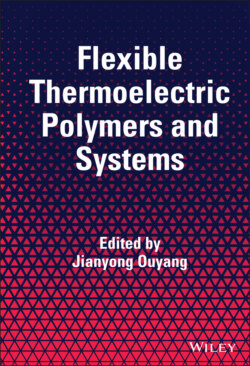Читать книгу Flexible Thermoelectric Polymers and Systems - Группа авторов - Страница 27
1.2.2 Effect of Electrical and Thermal Contact Resistances On Thermoelectric Performance
ОглавлениеApart from the ZT value of the thermoelectric materials, other factors can affect the thermoelectric efficiency as well. In addition to the thermoelectric materials, electrodes, heat sink, and cold sink are needed in thermoelectric generators. In a thermoelectric module, a p‐type thermoelectric leg is connected to an n‐type thermoelectric leg through a metallic contact layer, that is, electrode (Figure 1.19). Thus, there are interfaces between the thermoelectric materials and the contact layers. They introduce both electrical and thermal contact resistances. This lowers the thermoelectric performance of the module because of the Joule heat generation and the temperature drop at the contacts. For a thermoelectric leg with two contact layers at the two ends, the effective resistance (R e) will be increased by the contact resistance (R c),
(1.35)
where R is the resistance of the thermoelectric leg. The temperature drop (ΔT c) at the contacts lowers the actual temperature difference (ΔT) on the thermoelectric leg,
(1.36)
Figure 1.19 Schematic structure of a thermoelectric module with n‐type and p‐type thermoelectric legs.
where ΔT 0 is the temperature difference between the heat sink and the cold sink.
The deterioration of the thermoelectric performance by the electrical and thermal contact resistances can be modeled into their effects on the effective ZT value. If a thermoelectric leg with a length of l and figure of merit of ZT is connected to the contact layers with the conductivity of (σ con) and thermal conductivity of (κ con), the effective ZT e value will decrease,
(1.37)
where σ and κ are the electrical conductivity and thermal conductivity of the thermoelectric material, respectively. Thus, the decrease in the ZT value is related to the electrical conductivities and thermal conductivities of the contact layer and the thermal electric leg and the length of the thermoelectric leg. An effective material for the contact layer should have high electrical conductivity and high thermal conductivity. It is important to make the thermoelectric interfaces with small electrical and thermal contact resistances. To design high thermoelectric conversion efficiency, the contact area between the electrodes and thermoelectric legs and the length of the thermoelectric legs are important parameters [32, 33].
In addition, the thermal expansion coefficient of the contact layers should match with the thermoelectric legs particularly for high temperature application. Otherwise, the thermal expansion mismatching can produce fractures or cracks at the interfaces and thus increase the electrical and thermal contact resistances.
The energy conversion efficiency of a thermoelectric generator or module is the electrical power output divided by the heat power input. But it is difficult to accurately determine the heat power input. Thus, electrical powers instead of the efficiency values are usually provided in literature. The electrical power output depends on the temperature difference (ΔT). Because of the temperature dependences of the Seebeck coefficient, the ZT value and the resistances of thermoelectric legs and electrodes, the open‐circuit voltage and the total electrical resistance vary with ΔT as well. In addition, cracks and materials degradation can happen under thermal cycling. Thus, the evolutions of the power output, open‐circuit voltage and total electrical resistance are sometimes presented with the number of the thermal cycles.
